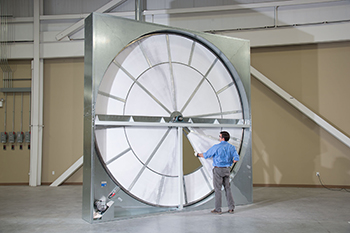 The quality of the air we breathe — both indoors and outdoors — is vital to our overall health. Indoor air pollutants in particular can have a major impact on occupant health if not properly controlled.
The quality of the air we breathe — both indoors and outdoors — is vital to our overall health. Indoor air pollutants in particular can have a major impact on occupant health if not properly controlled.
According to the American Lung Association, poor indoor air quality (IAQ) can cause or contribute to the development of infections, lung cancer and chronic lung disease such as asthma. In the U.S. alone, an estimated 40 million people are affected by allergies — a health concern that can be significantly reduced by improving the air quality in indoor environments.
As a result, the Environmental Protection Agency (EPA) declared IAQ a public health priority, and building regulations were put in place to control indoor air pollutants. For example, building codes require a minimum exchange of stale indoor air with fresh, outdoor air — a strategy confirmed by experts as key to reducing the concentration of air pollutants. Without a constant exchange of air, indoor pollutants — including formaldehyde, airborne viruses, humidity and other chemicals — can reach unhealthy levels. Poor IAQ can lead to the aforementioned respiratory diseases as well as, more generally, headaches, fatigue and occupant discomfort.
Exceeding code regulations is a strategy many building owners now use to attract and retain tenants. Studies have shown that increased ventilation rates have a positive impact on health by reducing all indoor pollutants to their lowest level. Fortunately, HVAC technology has progressed to the point where facilities managers no longer have to choose between low energy costs and optimal IAQ. Energy recovery ventilation (ERV) is a readily available and proven technology that reduces humidity control and ventilation energy costs up to 80 percent by recycling useful thermal energy contained within the building air. For new or replacement applications, initial costs for ERV are often largely offset by downsizing mechanical heating and cooling equipment because of the amount of useful thermal energy recycled by the ERV.
When considering the costs and benefits of increased ventilation rates, there are four major ERV benefits to keep in mind.
1. Health: ERV technology is the only ventilation strategy that can simultaneously reduce the levels of all indoor pollutants and reduce the size and operating cost of the HVAC system. Affordable fresh air eliminates the need to choose between energy savings and a healthy indoor environment.
2. Humidity: A major challenge for many facility managers occurs when trying to keep occupants comfortable on warm, humid days. Humidity contained in fresh outdoor air often overpowers the air-conditioning system. To reduce this challenge, consider an ERV that uses an enthalpy transfer device such as an energy recovery wheel. These devices remove up to 80 percent of the humidity from the incoming fresh air, resulting in cool air that is comfortable, dry and does not contribute to the formation of mold and mildew.
3. Productivity: A study conducted by the EPA found that a school’s indoor environment could have a significant impact on student attendance, learning and productivity. Research shows a clear link between poor IAQ and children’s health problems. Poor IAQ also correlates with reduced performance scores and increased absenteeism. In a work environment, research shows similar effects — the productivity of a company’s workforce is dramatically impacted when forced to work in a less-than-ideal environment.
4. Upfront Capital Equipment Cost Savings: In addition to significantly reducing energy costs, having an ERV in your HVAC design provides additional peak demand and capital equipment cost savings. Facility managers can expect minimal or no added upfront cost to installing an ERV in a retrofit or new construction project. Regardless of the ventilation rate, ERVs reduce HVAC design loads, enabling system designers to specify smaller, lower-cost HVAC equipment. This low first cost can be further offset with energy recovery incentives offered by many utility companies as well as local, state and federal governments.
ERV technology is a cost-effective means to eliminate a major challenge for building owners and facilities managers. The solution now exists where it is possible to achieve both lowered energy costs and improved IAQ. Increasing outdoor ventilation rates above code minimums while also increasing HVAC system efficiency with an ERV is a proven and affordable method of improving the health and comfort of building occupants.
Randall Steele is vice president and general manager of Airxchange, headquartered in Rockland, Mass.

